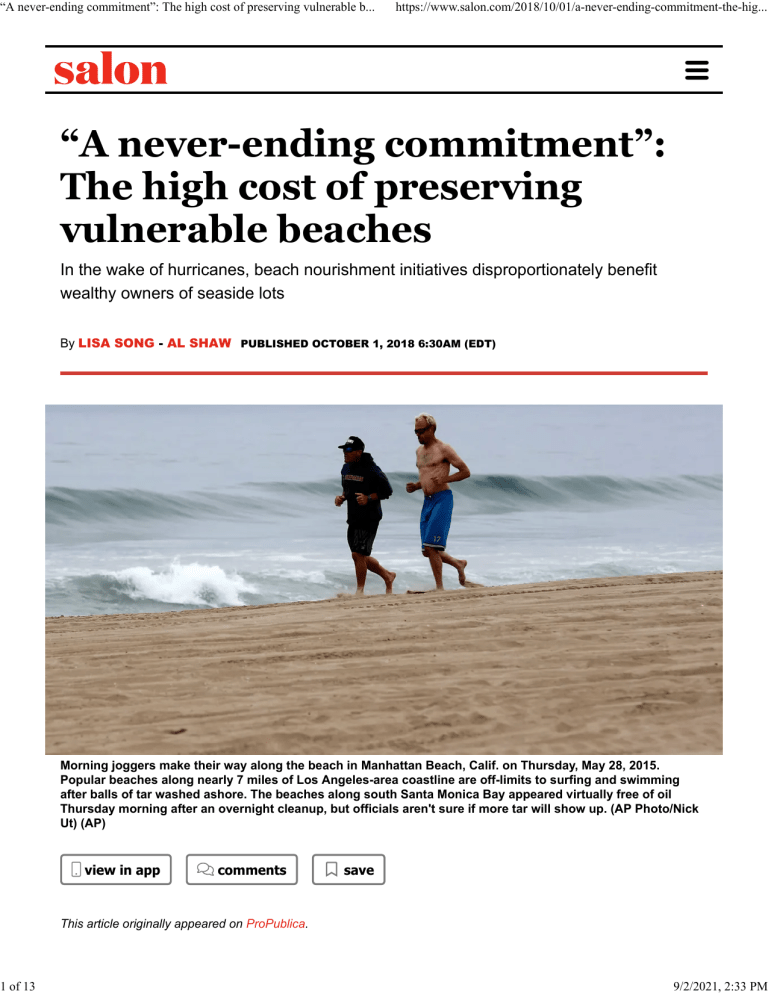
“A never-ending commitment”: The high cost of preserving vulnerable b...
1 of 13
https://www.salon.com/2018/10/01/a-never-ending-commitment-the-hig...
“A never-ending commitment”:
The high cost of preserving
vulnerable beaches
In the wake of hurricanes, beach nourishment initiatives disproportionately benefit
wealthy owners of seaside lots
By LISA SONG - AL SHAW PUBLISHED OCTOBER 1, 2018 6:30AM (EDT)
Morning joggers make their way along the beach in Manhattan Beach, Calif. on Thursday, May 28, 2015.
Popular beaches along nearly 7 miles of Los Angeles-area coastline are off-limits to surfing and swimming
after balls of tar washed ashore. The beaches along south Santa Monica Bay appeared virtually free of oil
Thursday morning after an overnight cleanup, but officials aren't sure if more tar will show up. (AP Photo/Nick
Ut) (AP)
view in app
comments
save
This article originally appeared on ProPublica.
9/2/2021, 2:33 PM
“A never-ending commitment”: The high cost of preserving vulnerable b...
2 of 13
https://www.salon.com/2018/10/01/a-never-ending-commitment-the-hig...
As lawmakers consider disaster relief in the wake of Hurricane Florence, projects to rebuild North
Carolina’s shrunken shorelines are likely to get a healthy chunk of government money.
To their advocates, these so-called beach nourishment initiatives are crucial steps in buffering
valuable oceanfront properties from storm damage and boosting local economies that rely on
tourism.
But such projects replenish the same vulnerable areas again and again, and disproportionately
benefit wealthy owners of seaside lots.
Moreover, pumping millions of cubic yards of sand onto beaches can cause environmental
damage, according to decades of studies. It kills wildlife scooped up from the ocean floor and
smothers mole crabs and other creatures where sand is dumped, said Robert Young, a geology
professor at Western Carolina University.
In the Rockaways in New York, where beaches have been rebuilt repeatedly, “the only foraging
shorebird you typically see is a seagull with a french fry in its mouth,” he said.
Advertisement:
9/2/2021, 2:33 PM
“A never-ending commitment”: The high cost of preserving vulnerable b...
3 of 13
https://www.salon.com/2018/10/01/a-never-ending-commitment-the-hig...
The U.S. has spent some $9 billion to rebuild beaches since 1923, a Western Carolina University
database shows. Federal, state and local governments have spent more than $828 million to
restock beaches in North Carolina alone since 1939, with much of that money coming from the
Army Corps of Engineers and the Federal Emergency Management Agency. In some cases, the
Corps’ support consists of in-kind donations of sand dredged from other construction projects.
Newly nourished beaches suffer less erosion after storms than nonreplenished beaches. But the
protection doesn’t last, as wind and wave damage chip away at the shore. The same North
Carolina beaches have been renourished over and over. Carolina Beach has been replenished
31 times since 1955. North Topsail Beach, part of a barrier island northeast of Wilmington, has
gotten fresh sand just about every year since 1997.
Advertisement:
“This is literally a never-ending commitment,” Young said. “I think most people would probably
agree, people in Kansas don’t have an interest in holding every beach in America in place.”
The Corps’ initial assessment of North Carolina beaches after Hurricane Florence found some
damage, but it wasn’t major. In Carteret County, which receives sand but no money from the
9/2/2021, 2:33 PM
“A never-ending commitment”: The high cost of preserving vulnerable b...
4 of 13
https://www.salon.com/2018/10/01/a-never-ending-commitment-the-hig...
Corps, shore protection director Gregory “Rudi” Rudolph estimated they’ll need new sand on 70
percent of their 25-mile long beach. In recent years, FEMA has supplied most of the county’s
beach nourishment funds through post-disaster grants.
Though the projects help beach economies overall, experts say federal funds favor
predominantly white, high-income towns, and even more so the properties right along the beach.
The value of erosion protection “decreases rapidly as you move in from the beachfront,” said
Mark Mauriello, a former commissioner of New Jersey’s environmental agency.
Advertisement:
A ProPublica analysis of 16 North Carolina communities directly behind beaches that have
received federal funds shows they’re 94 percent white on average; a quarter of owner-occupied
housing in these areas is worth more than $500,000 (compared with 7 percent in North Carolina
as a whole).
One of the beneficiaries in North Carolina is Wrightsville Beach, a town of 2,500 that has had $51
million worth of beach projects since 1990.
Oceanfront homes in the town are worth millions. A $4.25 million, six-bedroom house for sale on
Trulia boasts “180 degree views of the Atlantic Ocean” and is “tucked behind 200 feet of
protective dunes.”
9/2/2021, 2:33 PM
“A never-ending commitment”: The high cost of preserving vulnerable b...
5 of 13
https://www.salon.com/2018/10/01/a-never-ending-commitment-the-hig...
An analysis of county assessment data shows that residential properties in Wrightsville within
approximately 250 feet of the beach are worth $500,000 more on average than homes in the city
overall.
The Corps, tasked with managing flood risk across America, takes on engineering projects like
building levees and renourishing beaches ostensibly because they prevent property damage
from future disasters and lock valuable beaches in place. The Corps prioritizes projects that
would prevent the most amount of damage per dollar spent. This tends to favor beach building in
high-income communities full of pricey properties.
Advertisement:
The Corps generally funds projects only when the expected benefit is 2.5 times as high as the
project’s cost. Poor communities can’t meet that criteria, said Derek Brockbank, executive
director of the American Shore & Beach Preservation Association. Brockbank’s group advocates
for federal funding of beach nourishment and lobbied on Hurricane Sandy recovery legislation.
Andrew Kahrl, a history professor at the University of Virginia, said he couldn’t think of a single
project that primarily benefited people of color. His research shows how the historically black
communities that lived along the Carolinas’ coast were forced out by developers and federal
infrastructure projects, including some built by the Corps.
9/2/2021, 2:33 PM
“A never-ending commitment”: The high cost of preserving vulnerable b...
6 of 13
https://www.salon.com/2018/10/01/a-never-ending-commitment-the-hig...
Ultimately, the towns that get funding need to be politically connected and prosperous enough to
carry some of the costs, he said.
Corps spokesman Gene Pawlik said the agency doesn’t use community demographics when
considering which beaches to support, but it may consider how vulnerable populations such as
the elderly and the disabled are affected by storm damage, he said in an email.
Advertisement:
Beach projects are supposed to be supported, in part, by local funding. The first time around, the
federal government usually pays 65 percent. Repeat applications are generally split 50-50 with
the Corps.
A.R. Siders, an environmental fellow at Harvard University who studies coastal climate change
and adaptation, said the program would be more sustainable if local governments paid a higher
share of the cost. If those who benefit the most take on more of the financial burden, Siders said,
it might encourage community leaders to enact zoning regulations or take other steps to reduce
flood risk.
It’s gotten harder to pry funding from Congress during the regular appropriations process, which
budgets $50 million to $70 million annually for beach nourishment, Brockbank said. But after
major storms, massive relief bills can include many times as much money.
9/2/2021, 2:33 PM
“A never-ending commitment”: The high cost of preserving vulnerable b...
7 of 13
https://www.salon.com/2018/10/01/a-never-ending-commitment-the-hig...
The post-Hurricane Sandy aid package included more than $5 billion for Corps repairs, and a
significant portion went to beaches. A Corps spokesperson said the North Atlantic region has
spent $1.5 billion so far on renourishment. In some cases, the Corps paid 100 percent of the
costs.
Advertisement:
Mauriello, the former state environmental commissioner, said the political calculus changes after
storms: Beaches that wait year after year for money through the regular budget process
suddenly receive Congress’ benevolence. According to the Corps, three-quarters of the $1.5
billion went to projects that were new or were only half-completed when the storm struck.
A 2015 study said oceanfront properties in New Jersey could lose up to a third of their property
value if the federal government stopped subsidizing beach nourishment.
Emergency funding also comes from FEMA. Towns with previously replenished beaches can
apply after major disasters to replace the sand lost in the storm.
In 2011, the town of Nags Head on the Outer Banks used local and county funds for a $36 million
project. In 2016, Hurricane Matthew washed much of that sand away. So FEMA gave it $16
million to help replace that sand.
Advertisement:
9/2/2021, 2:33 PM
“A never-ending commitment”: The high cost of preserving vulnerable b...
8 of 13
https://www.salon.com/2018/10/01/a-never-ending-commitment-the-hig...
A FEMA spokesperson said the agency only funds projects that meet certain criteria: For
example, communities that already receive money from the Corps are ineligible. When asked
whether beach nourishment was an appropriate use of federal taxpayer dollars, the agency said
its practices are based on disaster relief laws.
After Hurricanes Joaquin, Matthew and Irma, FEMA also gave a total of $3 million to Hilton Head
Island, about 10 percent of what the South Carolina resort town needed, said Scott Liggett, the
town’s director of public projects and facilities. The bulk of the money came from local funds.
Liggett said Hilton Head has supported virtually all of its beach nourishment since 1993. The
money comes from an accommodations tax that generates $6 million a year through hotels and
seasonal vacation rentals and is sustainable at least through 2035, he said.
“I think we are truly unique,” Liggett said. “I know we are in this state, and maybe even in the
East Coast.”
9/2/2021, 2:33 PM
“A never-ending commitment”: The high cost of preserving vulnerable b...
9 of 13
https://www.salon.com/2018/10/01/a-never-ending-commitment-the-hig...
Advertisement:
Hilton Head’s model is hard to follow. Debbie Smith, the mayor of Ocean Isle Beach, North
Carolina, said her small town doesn’t have enough of a tax base to pay for beach projects, so
they are “extremely” dependent on federal funds.
Ocean Isle has received $33 million worth of beach nourishment since 2001. The town of 650
has 4,000 housing units, so it relies on tourists and second homeowners. A 5 percent
accommodations tax accounts for nearly half of the town’s general fund, she said, and about
25,000 visit the beach every summer.
When asked about sea-level rise and the long-term sustainability of beach nourishment, Smith
said there was “a lot of difference of opinion” about global warming projections. “I’m not a
scientist,” she said, echoing a favorite talking point of politicians who reject the scientific
consensus on climate change.
9/2/2021, 2:33 PM
“A never-ending commitment”: The high cost of preserving vulnerable b...
10 of 13
https://www.salon.com/2018/10/01/a-never-ending-commitment-the-hig...
Advertisement:
Smith compared the vacationers in her town to visitors at national parks. “We have homeowners
from almost every state in the union,” she said, so if the federal government funds those parks,
why shouldn’t it help towns like Ocean Isle? Taxpayers “come and enjoy our beaches,” she said.
“They need to help us maintain them for their enjoyment.”
LISA SONG
MORE FROM LISA SONG
AL SHAW
MORE FROM AL SHAW
9/2/2021, 2:33 PM
“A never-ending commitment”: The high cost of preserving vulnerable b...
11 of 13
https://www.salon.com/2018/10/01/a-never-ending-commitment-the-hig...
Related Topics -----------------------------------------Beach Nourishment
Beaches
Fema
Hurricane Florence
North Carolina
Propublica
Related Articles
9/2/2021, 2:33 PM
“A never-ending commitment”: The high cost of preserving vulnerable b...
12 of 13
https://www.salon.com/2018/10/01/a-never-ending-commitment-the-hig...
9/2/2021, 2:33 PM
“A never-ending commitment”: The high cost of preserving vulnerable b...
13 of 13
Home
About
Staff
Contact
https://www.salon.com/2018/10/01/a-never-ending-commitment-the-hig...
Privacy
Terms of Service
Archive
Go Ad Free
Copyright © 2021 Salon.com, LLC. Reproduction of material from any Salon pages
without written permission is strictly prohibited. SALON ® is registered in the U.S. Patent
and Trademark Office as a trademark of Salon.com, LLC. Associated Press articles:
Copyright © 2016 The Associated Press. All rights reserved. This material may not be
published, broadcast, rewritten or redistributed.
DMCA Policy
9/2/2021, 2:33 PM




